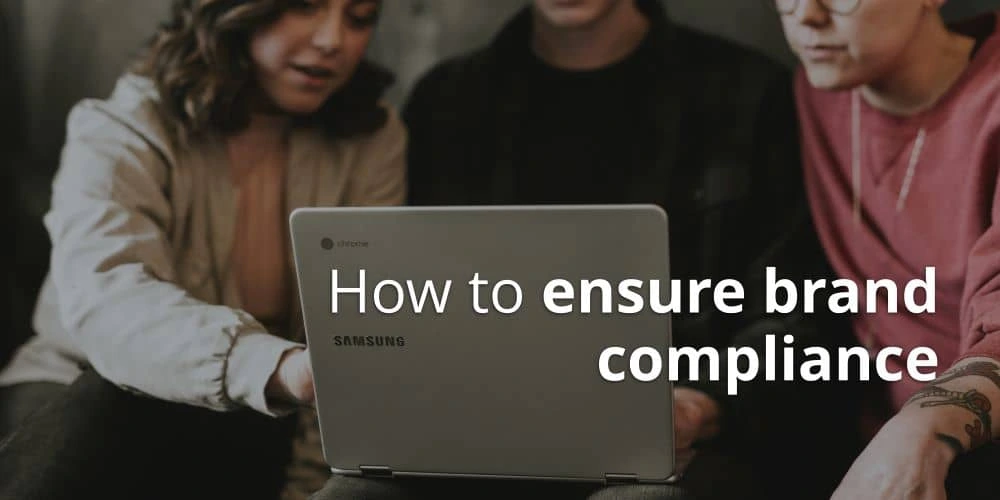Protecting your brand—not only how it looks but also how it’s perceived—is essential.
Your brand is everything that makes up how your customers see you, and if you’re not presenting a consistent message across the board, you run the risk of confusing, alienating or even frustrating your customers. On top of that, you’re missing out on the opportunity to establish your brand and grow recognition, authority and trust.
If you’re operating in a multi-location company with staff working in various departments, establishing a process to ensure brand compliance is key.
Related: 10 examples of great brand guidelines
Where once a central marketing team might have created and controlled all marketing output, we’re now working in a much more democratic and fast-paced world. Branding, content and communications can’t just sit with one team anymore; it’s become a multi-player, multi-platform game that almost everyone in your company is involved in.
So when artistic license, so to speak, is given far and wide, how do you ensure consistency across the board—especially when it comes to multi-location branding?
How to ensure brand compliance
For many companies, frequent barriers to brand compliance include:
- Overworked designers with too many requests and slow workflows
- Wasted time for designers when things move too quickly or changes aren’t communicated
- Content that isn’t on-brand (usually arising from the need for a quick turnaround by a rogue team or individual)
- Outdated brand assets where the latest versions haven’t been made available, aren’t centrally stored, or don’t exist
- No brand manager who’s enforcing the guidelines and implementing smarter processes
- Over-complicated branding that’s difficult to follow
Luckily, with a growing list of new approaches to these old problems, the future of your brand looks bright.
Ramp up your brand compliance efforts by employing these two fail-safe strategies.
Create and implement brand compliance guidelines
With the creation of effective and detailed brand compliance guidelines, you’re dramatically improving your company’s chances of consistency.
Our report on the importance of brand consistency revealed that companies are twice as likely to see a consistent presentation of their brand when formal brand guidelines are in place and enforced.
A typical set of brand guidelines will cover:
- Logo variations & dimensions, plus details on when and how to use them
- Brand colors for both digital & print
- Brand fonts, sizes & suggested uses
- Tone of voice & brand messaging
The goal with your brand guidelines isn’t to limit the creativity of your marketers and designers, but to give them a set of guidelines to work within. There should still be plenty of opportunity for them to come up with new and exciting ideas that comply.
When it comes to enforcing brand guidelines, you’ll do a whole lot better if you can take away the challenges your people face.
As an absolute minimum, make sure the guidelines are easy to follow and centrally stored so that everyone—including partners—can access them without hassle.
The next step is to support all your people (not just your designers) by providing the resources they need to comply. With clear guidelines and easy processes, you’re leaving little room for error.
Create shared resources & customizable content templates
This strategy—known as distributed marketing management—is becoming an increasingly popular option for growing organizations who take brand compliance seriously.
Rather than relying on an overworked design team to churn out request after request (often with a lengthy turnaround time), customizable templates put some of the responsibility back with the individual or local team.
A modern brand management system such as Marq will empower local marketers and salespeople to create their own content and campaigns that still adhere to brand guidelines.
With the introduction of innovative software like Marq, you’ll get the following benefits:
- Shared access to a single platform with permission controls
- A central resource bank where only the latest versions are available
- Access from anywhere with cloud-based storage
- Lockable templates, so edits can be made without compromising branding
- Intuitive software that’s easy for everyone
- Simple multi-channel distribution across print & digital
With a system like this in place, you’re giving your people the power to act quickly and take advantage of local opportunities without compromising brand compliance.
Further, by opening this process up to your partners and affiliates, you see even more rewards. When you can give them access to brand guidelines and templates that are locked down, they’ll have more independence when it comes to collaborating and cross-promoting. All without putting extra pressure on your marketing team.
Sounds like a dream, doesn’t it?
Key takeaway
Total brand compliance is achievable, but it takes forward-planning, smart software and well-thought-out processes. To give your brand the best chance of success, create and enforce formal brand guidelines and implement a central system for sharing on-brand resources and customizable templates.
Instead of trying (and failing) to do everything for your people, give them the guidance and tools they need to do things for themselves.



